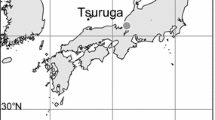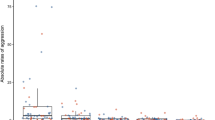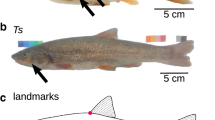Abstract
Traditionally, the origin of new species from disjoint populations has been thought to be due to the accumulation of mutations, genetic drift, or to local, divergent adaptation. It has also been proposed that sexual selection can accelerate, or even generate, reproductive isolation. Although there is some evidence that female choice is strong enough to generate reproductive isolation, the mechanism by which isolation is produced is still poorly understood. Here we show that (1) the population-characteristic male courtship behaviour of the amarillo fish (Girardinichthys multiradiatus, Meek) is modified in the presence of females from other populations, that (2) this is due to the males responding to subtle cues from females, but that (3) the resulting courtship style does not match the female’s population-characteristic behaviour. We conclude that the interplay between male courtship and female responsiveness has led to the evolution of local variants in courtship style that hamper communication between allopatric individuals and promote pre-mating isolation.


Similar content being viewed by others
References
Andersson M (1994) Sexual selection. Princeton University Press, Princeton
Baker MC (1975) Song dialects and genetic differences in white-crowned sparrows Zonotrichia leucophrys. Evolution 29:226–241
Baker MC (1982) Vocal dialect recognition and population genetic consequences. Am Zool 22:561–569
Baker MC, Cunningham MA (1985) The biology of bird song dialects. Behav Brain Sci 8:85–133
Bakker TCM (1993) Positive genetic correlation between female preference and preferred male ornament in sticklebacks. Nature 363:255–257
Bateman AJ (1948) Intra-sexual selection in Drosophila. Heredity 2:349–368
Candolin U (2000) Increased signalling effort when survival prospects decrease: male-male competition ensures honesty. Anim Behav 60:417–422
Coleman SW, Patricelli GL, Borgia G (2004) Variable female preferences drive complex male displays. Nature 428:742–745
Dabelsteen T (2005) Public, private or anonymous? Facilitating and countering eavesdropping. In: McGregor P (ed) Animal communication networks. Cambridge University Press, Cambridge, UK, pp 38–62
Endler JA (1987) Predation, light intensity and courtship behaviour in Poecilia reticulata (Pisces: Poeciliidae). Anim Behav 35:1376–1385
Endler JA, Houde AE (1995) Geographic variation in female preferences for male traits in Poecilia reticulata. Evolution 49:456–468
Ficken MS, Ficken RW, Apel KM (1985) Dialects in a call associated with pair interactions in the black-capped chickadee. Auk 102:145–151
Gesundheit P, Macías Garcia C (2005) Biogeografía cladística de la familia Goodeidae (Cyprinodontiformes). In: Llorente Bousquets J, Morrone JJ (eds) Regionalización Biogeográfica en Iberoamérica y Tópicos Afines. Facultad de Ciencias, UNAM, México City, pp 319–338
González Zuarth C, Macías Garcia C (2006) Phenotypic differentiation and pre-mating isolation between allopatric populations of Girardinichthys multiradiatus. Proc R Soc Lond B 273:301–307
Houde AE, Endler JA (1990) Correlated evolution of female mating preferences and male color patterns in the guppy Poecilia reticulata. Science 248:1405–1408
Houle D, Kondrashov AS (2002) Coevolution of costly mate choice and condition-dependent display of good genes. Proc R Soc Lond B 269:97–104
Knight ME, Turner GF (2004) Laboratory mating trials indicate incipient speciation by sexual selection among populations of the cichlid fish Pseudotropheus zebra from Lake Malawi. Proc R Soc Lond B 7:675–680
Kokko H (1998) Should advertising parental care be honest? Proc R Soc Lond B 265:1871–1878
Lande R (1981) Models of speciation by sexual selection on polygenetic traits. Proc Natl Acad Sci USA 78:3721–3725
Lande R (1982) Rapid origin of sexual isolation and character divergence in a cline. Evolution 36:213–223
Luyten PH, Liley NR (1985) Geographic variation in the sexual behaviour of the guppy, Poecilia reticulata (Peters). Behaviour 95:164–179
Luyten PH, Liley NR (1991) Sexual selection and competitive mating success of males guppies (Poecilia reticulata) from four Trinidad populations. Behav Ecol Sociobiol 28:329–336
Macias Garcia C (1994) Social behavior and operational sex ratios in the viviparous fish Girardinichthys multiradiatus. Copeia 1994:919–925
Macías Garcia C (1991) Sexual behaviour and trade-offs in the viviparous fish Girardinichthys multiradiatus. Unpublished PhD thesis, University of East Anglia, Norwich, UK
Macías Garcia C, Saborio E, Berea C (1998) Does male-biased predation lead to male scarcity in viviparous fish? J. Fish Biol 53:104–117
Magurran AE (1998) Population differentiation without speciation. Phil Trans R Soc Lond B 353:275–286
Magurran AE, Seghers BH (1990) Risk sensitive courtship in the guppy (Poecilia reticulata). Behaviour 112:194–201
Magurran AE, Seghers B (1994) Sexual conflict as a consequence of ecology: evidence from guppy, Poecilia reticulata, populations in Trinidad. Proc R Soc Lond B 255:31–36
Marler P (1960) Bird songs and mate selection. In: Lanyon WE, Tavolga WN (eds) Animal and sounds communication. American Institute of Biological Sciences Symposium Proceedings. No. 7, Washington DC, USA, pp 348–367
Marler P, Tamura M (1962) Song “dialects” in three populations of white-crowned sparrows. Condor 64:368–377
Mundinger PC (1982) Microgeographic and macrogeographic variation in acquired vocalizations in birds. In: Kroodsma DE, Miller EH (eds) Acoustic communication birds, vol 2. Academic Press, New York, pp 174–208
Olofsson H, Servedio MR (2008) Sympatry affects the evolution of genetic versus cultural determination of song. Behav Ecol 19:594–604
Patricelli GL, Uy JAC, Walsh G, Borgia G (2002) Male displays adjusted to female’s responses. Nature 415:279–280
Patricelli GL, Uy JAC, Borgia G (2004) Female signals enhance the efficiency of mate assessment in satin bowerbirds (Ptilonorhynchus violaceus). Behav Ecol 15:297–304
Patricelli GL, Coleman SW, Borgia G (2006) Male satin bowerbirds, Ptilonorhynchus violaceus, adjust their display intensity in response to female startling: an experiment with robotic females. Anim Behav 71:49–59
Riebel K (2003) The “mute” sex revisited: vocal production and perception learning in female songbirds. Adv Study Behav 33:49–86
Ritchie MG (1996) The shape of female mating preferences. Proc Natl Acad Sci 93:14628–14631
Ryan MJ, Wilczynski W (1988) Coevolution of sender and receiver: effect on local mate preference in cricket frogs. Science 240:1786–1788
Ryan MJ, Wilczynski W (1991) Evolution of intraspecific variation in the advertisement call of a cricket frog (Acris crepitans, Hylidae). Biol J Linn Soc 44:249–271
Santangelo N (2005) Courtship in the monogamous convict cichlid; what are individuals saying to rejected and selected mates? Anim Behav 69:143–149
Seehausen O, van Alphen JJM (1998) The effect of male coloration on female mate choice in closely related Lake Victoria cichlids (Haplochromis nyererei complex). Behav Ecol Sociobiol 42:1–8
Slabbekoorn H, Smith TB (2002) Birdsong, ecology, and speciation. Phil Trans R Soc B 357:493–503
Stoner G, Breden F (1988) Phenotypic differentiation in female preference related to geographic variation in male predation risk in the Trinidad guppy (Poecilla reticulata). Behav Ecol Sociobiol 22:285–292
Sutherland WJ (1985) Chance can produce a sex difference in variance in mating success and explain Bateman’s data. Anim Behav 33:1349–1352
Takahashi D, Kohda M (2004) Courtship in fast water currents by a male stream goby (Rhinogobius brunneus) communicates the parental quality honestly. Behav Ecol Sociobiol 55:431–438
Tuttle MD, Ryan MJ (1981) Bat predation and the evolution of frog vocalizations in the neotropics. Science 214:677–678
Uy JA, Borgia G (2000) Sexual selection drives rapid divergence in bowerbird displays traits. Evolution 54:273–278
Valero A, Hudson R, Avila Luna E, Macías Garcia C (2005) A cost worth paying: energetically expensive interactions with males protect females from intrasexual aggression. Behav Ecol Sociobiol 59:262–269
Webb SA, Graves JA, Macías Garcia C et al (2004) Molecular phylogeny of the livebearing Goodeidae (Cyprinodontiformes). Mol Phil Evol 30:527–544
West-Eberhard MJ (1989) Phenotypic plasticity and the origins of diversity. Ann Rev Ecol Syst 20:249–278
Wilczynski W, Ryan MJ (1999) Geographic variation in animal communication systems. In: Foster SA, Endler JA (eds) Geographic diversification of behavior: an evolutionary perspective. Oxford University Press, Oxford, UK, pp 234–261
Acknowledgments
We thank E. Avila and E. Tobón for considerable help in the field. This project was partially supported with a grant from CONACyT to C.M.G, and is part of C. G. Z.’s Ph.D. thesis. Carlos Cordero advised on the convenience to explore female behavioural differences, and two anonymous referees provided much constructive feedback. This research adhered to the Association for the Study of Animal Behaviour/Animal Behavior Society Guidelines for the Use of Animals in Research, local legislation and institutional code of conduct.
Author information
Authors and Affiliations
Corresponding author
Rights and permissions
About this article
Cite this article
Gonzalez-Zuarth, C.A., Vallarino, A. & Macías Garcia, C. Female responsiveness underlies the evolution of geographic variation in male courtship between allopatric populations of the fish Girardinichthys multiradiatus . Evol Ecol 25, 831–843 (2011). https://doi.org/10.1007/s10682-010-9449-3
Received:
Accepted:
Published:
Issue Date:
DOI: https://doi.org/10.1007/s10682-010-9449-3




